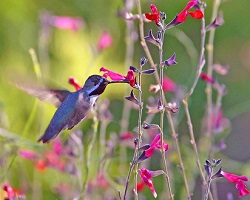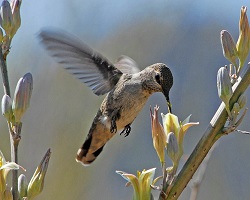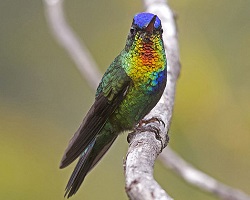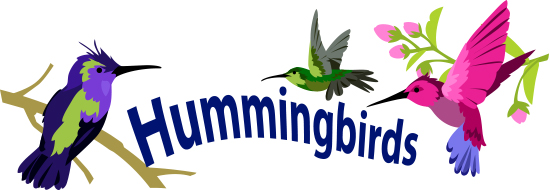Eyes Like a Hawk? Or Like a Hummingbird?

Vision is a hummingbird's most important sense. The hummingbird is a fast flier that makes a lot of changes in direction. Without good eyesight, it would run right into things.
Furthermore, hummingbirds don't have a great sense of smell, and most species only make a few alarm calls and squeaks.
Except for the hermit hummingbirds, most don't sing elaborate songs to attract females or chase off rivals, unlike songbirds. This means that most hummingbirds rely on vision to let them find food and mates.

Hummingbirds see color just as well as humans. In fact, they can also see ultraviolet light, which means their world appears even more colorful than ours.
Does Color Matter?
Flowers are often colorful. Bright colors signal to the hummingbird that it might be about to find a tasty nectar snack.
Red flowers are regularly visited by hummingbirds, and many people use red feeders because they believe hummingbirds won't drink from a feeder of a different color.
So why do hummingbirds flock to the red feeders? Is it the red color? Or could it be that hummingbirds are simply after the good source of energy, not a favorite color? (To test this idea, check out our hummingbird experiment.)
Flashy Feathers
If you look at a perched male hummingbird, he might sport a loud patch of red. But if you move your head to the side, suddenly that bird may look purple, or black, or any number of colors depending on his species. What's going on?

Many birds have colorful feathers because of the pigments contained inside. These are similar to the dyes that give your clothing color. However, you probably don't own any clothes that change color depending on how you look at them, and there's a good reason for that.
Feathers that change colors (called iridescent feathers) look that way because of what scientists call "structural coloration." This means that it is the structure of the feather itself and how it affects sunlight that causes it to look a particular way.
Sunlight is made of many wavelengths of light, which are responsible for all the colors we see. Feathers with structural color reflect, scatter, or absorb different wavelengths in different ways, resulting in changing color.
Additional images via Wikimedia Commons. Hummingbird feather by Brocken Inaglory.
Read more about: Hummingbirds
Bibliographic details:
- Article: Hummingbird Vision and Color
- Author(s): Dr. Biology
- Publisher: Arizona State University School of Life Sciences Ask A Biologist
- Site name: ASU - Ask A Biologist
- Date published:
- Date accessed:
- Link: https://askabiologist.asu.edu/vision-and-color
APA Style
Dr. Biology. (). Hummingbird Vision and Color. ASU - Ask A Biologist. Retrieved from https://askabiologist.asu.edu/vision-and-color
Chicago Manual of Style
Dr. Biology. "Hummingbird Vision and Color". ASU - Ask A Biologist. . https://askabiologist.asu.edu/vision-and-color
Dr. Biology. "Hummingbird Vision and Color". ASU - Ask A Biologist. . ASU - Ask A Biologist, Web. https://askabiologist.asu.edu/vision-and-color
MLA 2017 Style

Hummingbirds can see in color and they have special feathers with iridescent coloration.
Be Part of
Ask A Biologist
By volunteering, or simply sending us feedback on the site. Scientists, teachers, writers, illustrators, and translators are all important to the program. If you are interested in helping with the website we have a Volunteers page to get the process started.

